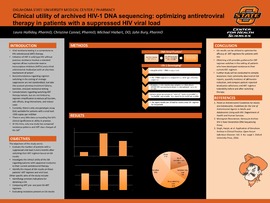| dc.contributor.author | Holliday, Laura | |
| dc.contributor.author | Connel, Christina | |
| dc.contributor.author | Hiebert, Michael | |
| dc.contributor.author | Bury, John | |
| dc.date.accessioned | 2020-04-14T16:12:32Z | |
| dc.date.available | 2020-04-14T16:12:32Z | |
| dc.date.issued | 2019-02-22 | |
| dc.identifier | ouhd_holliday_clinicalutilityofarchived_2019 | |
| dc.identifier.citation | Holliday, L., Connel, C., Hiebert, M., & Bury, J. (2019, Feb. 22). Clinical utility of archived HIV-1 DNA sequencing: Optimizing antiretroviral therapy in patients with a suppressed HIV viral load. Poster presented on Research Day at the Oklahoma State University Center for Health Sciences, Tulsa, OK. | |
| dc.identifier.uri | https://hdl.handle.net/11244/323842 | |
| dc.description.abstract | Introduction: Viral resistance testing is a cornerstone for selecting antiretroviral therapy (ART) in patients with HIV. Recommendations regarding regimen switching in the setting of virologic suppression are not standardized, but genotypic assays are frequently utilized in this scenario to help determine an efficacious medication regimen. Currently, only one genotypic assay (GA) is available for patients whose HIV RNA is less than 500 copies/mL. Little data exists for its clinical significance or utility in practice. | |
| dc.description.abstract | Research Question or Hypothesis: This study aims to assess the utility of the GA by comparing ART regimens and HIV RNA pre- and post-GA. | |
| dc.description.abstract | Study Design: This study is a retrospective chart review based on GA reports obtained historically through the Oklahoma State University Internal Medicine Specialty Clinic electronic medical record. | |
| dc.description.abstract | Methods: The information gathered consisted of clinical indications for a GA, mutations on GA results, ART at the time of the archive draw, and ART post-GA results. Demographic and disease related information will also be collected. Other information gathered included reported compliance to therapy, and regimen tolerability. | |
| dc.description.abstract | Results: Data were gathered from 67 patients, primarily male (87%), with an average age of 45. The most common indications for obtaining a GA were baseline testing (29.8%), re-establishing care (25.4%), and history of non-adherence (20.9%). Approximately half (49%) of patients had an undetectable viral load 3 months after switching their ART regimen based on GA results. | |
| dc.format | application/pdf | |
| dc.language | en_US | |
| dc.publisher | Oklahoma State University Center for Health Sciences | |
| dc.rights | The author(s) retain the copyright or have the right to deposit the item giving the Oklahoma State University Library a limited, non-exclusive right to share this material in its institutional repository. Contact Digital Resources and Discovery Services at lib-dls@okstate.edu or 405-744-9161 for the permission policy on the use, reproduction or distribution of this material. | |
| dc.title | Clinical utility of archived HIV-1 DNA sequencing: Optimizing antiretroviral therapy in patients with a suppressed HIV viral load | |
| osu.filename | ouhd_holliday_clinicalutilityofarchived_2019.pdf | |
| dc.type.genre | Presentation | |
| dc.type.material | Text | |
